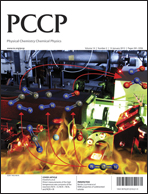Reply to the ‘Comment on “HCl adsorption on ice at low temperature: a combined X-ray absorption, photoemission and infrared study”’ by J. P. Devlin and H. Kang, Phys. Chem. Chem. Phys., 2012, 14, DOI: 10.1039/c1cp22007a
Abstract
In their Comment, Devlin and Kang (DK) reinterpret the infrared data published in our previous article (P. Parent, J. Lasne, G. Marcotte and C. Laffon, Phys. Chem. Chem. Phys., 2011, 13, 7142), which look similar to those already published by V. Buch, J. Sadlej, N. Aytemiz-Uras and J. P. Devlin, J. Phys. Chem. A, 2002, 106, 9374 and J. P. Devlin, N. Uras, J. Sadlej and V. Buch, Nature, 2002, 417, 269, using assignments based on their previous model calculations (V. Buch, J. Sadlej, N. Aytemiz-Uras and J. P. Devlin, J. Phys. Chem. A, 2002, 106, 9374), with which we partially agree. However, some parts of their infrared interpretation are inconsistent with our


 Please wait while we load your content...
Please wait while we load your content...